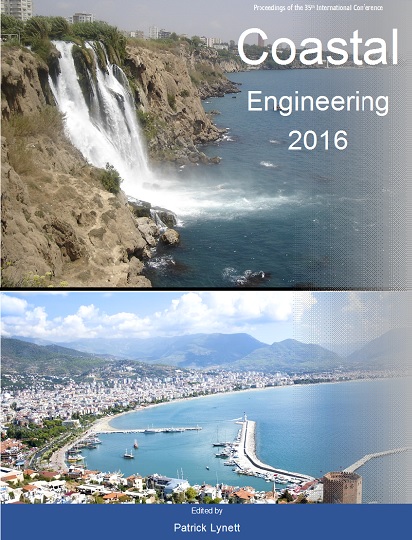Abstract
On March 11, 2011 the Tohoku tsunami event caused the death of thousands of people and generated billions of dollars in damages. Following this and previous tsunami events, there has been an effort to improve tsunami risk mitigation for coastal communities. Currently, numerical models are being used in a state-of-the-art methodology to estimate tsunami risk from near and far field sources. Model predictions are essential for the development of Tsunami Hazard Assessments (THA). By better understanding model bias and uncertainties and if possible minimizing them, a more accurate and reliable THA will result. In this study we compare runup height, inundation lines and flow velocity field measurements between GeoClaw and the Method Of Splitting Tsunami (MOST) predictions in the Sendai plain. Runup elevation and average inundation distance was in general over predicted by the models. However, both models agree relatively well with each other when predicting maximum sea surface elevation and maximum flow velocities. Model predictions show that the flow velocity increases as the tsunami wave front reaches the shoreline and makes its way inland for a couple of kilometers, contrary to what it is generally assumed. The tsunami models used in this study show much more variability when predicting flow velocity than predicting runup elevations and inundation lines. The results provided in this study will help understand the uncertainties in model predictions and locate possible sources of errors within a model.References
Arcos, M.E.M., Leveque, R.J. (2015), Validating velocities in the GeoClaw tsunami model using observations near Hawaii from the 2011 Tohoku tsunami. Pure Appl. Geophys., 172 (3-4) (this issue), doi:10.1007/s00024-014-0980-y
Berger, M. J., D. L. George, R. J. LeVeque, and K. T. Mandli (2011). The GeoClaw software for depth-averaged flows with adaptive refinement, Adv. Water Res. 34, 1195-1206.
Geist, E.L., and Parsons, T., (2006), Probabilistic analysis of tsunami hazards: Natural Hazards, v. 37, p. 277-314.
George, D. L., and R. J. LeVeque (2006). Finite volume methods and adaptive refinement for global tsunami propagation and local inundation, Science of Tsunami Hazards 24, 319-328.
George, D. L. (2008). Augmented Riemann solvers for the shallow water equations over variable topography with steady states and inundation, J. Comput. Phys. 227, 3089-3113.
González, F. I., et al. (2007), Scientific and technical issues in tsunami hazard assessment of nuclear power plant sites, NOAA Tech. Memo. OAR PMEL-136, NTIS: PB2008-101460, Pacific Marine Environmental Laboratory, Seattle, Wash., 125 pp. + appendices on CD.
Gonzalez, F.I., Geist, E.L., Jaffe, B., Kanoglu, U., Nofjeld, H., Synolakis, C.E., and fifteen others, (2009), Probabilistic tsunami hazard assessment at Seaside, Oregon, for near- and far-field seismic sources: Journal of Geophysical Research-Oceans, 114:C11023, Jan. 2009.
Gonzalez, F., R. J. LeVeque , P. Chamberlain, B. Hirai, J. Varkovitzky, and D. L. George (2011), GeoClaw Results for the NTHMP Tsunami Benchmark Problems, [NTHMP] National Tsunami Hazard Mitigation Program. 2012. Proceedings and Results of the 2011 NTHMP Model Benchmarking Workshop. Boulder: U.S. Department of Commerce/NOAA/NTHMP; (NOAA Special Report). 436 p.
Gonzalez, F.I., LeVeque, R.J., and Adams, L.M., (2013), Probabilistic Tsunami Hazard Assessment (PTHA) for Crescent City, CA, Final Report on Phase I, January 31, 2013: University of Washington Report, 70 p.
Koshimura, S.; Hayashi, S. (2012), Tsunami flow measurement using the video recorded during the 2011 Tohoku tsunami attack, Geoscience and Remote Sensing Symposium (IGARSS), 2012 IEEE International , vol., no., pp.6693,6696, 22-27 July 2012 doi: 10.1109/IGARSS.2012.6352063
R. J. LeVeque. Wave propagation algorithms for multi-dimensional hyperbolic systems. J. Comput. Phys., 131:327-353, 1997.
R. J. LeVeque. Finite Volume Methods for Hyperbolic Problems. Cambridge University Press, 2002.
R. J. LeVeque and D. L. George. High-resolution finite volume methods for the shallow water equations with bathymetry and dry states. In P. L. Liu, C. Synolakis, and H. Yeh, editors, Advanced Numerical Models for Simulating Tsunami Waves and Runup, volume 10 of Advances in Coastal and Ocean Engineering, pages 43-73. World Scientific, 2008.
Lynett, P. J., J. Borrero, S. Son, R. Wilson, and K. Miller (2014), Assessment of the tsunami-induced current hazard, Geophys. Res. Lett., 41, 2048-2055, doi:10.1002/2013GL058680.
Lynett, P., Borrero, J., Weiss, R., Son, S., Greer, D., Renteria, W. (2012) Observations and Modeling of Tsunami-Induced Currents in Ports and Harbors, Earth and Planetary Science Letters, 327-328 (68-74).
Mori, N., T. Takahashi, T. Yasuda, and H. Yanagisawa (2011), Survey of 2011 Tohoku earthquake tsunami inundation and run-up, Geophys. Res. Lett., 38, L00G14, doi:10.1029/2011GL049210.
Titov VV, Synolakis CE. (1995) Modeling of breaking and nonbreaking long wave evolution and runup using VTSC-2, J. Waterw. Port Coast Ocean Eng., 121, pp. 308-316.
Titov, V. and F. I. Gonzalez: (1997), 'Implementation and testing of the Method of Splitting Tsunami (MOST) model'. Technical Report NOAA Tech. Memo. ERLPMEL-112 (PB98-122773), NOAA/Pacific Marine Environmental Laboratory, Seattle, WA.
Titov VV, Synolakis CE. (1998) Numerical modeling of tidal wave runup. J. Waterw. Port Coast Ocean Eng., 124, pp. 157-171. (doi:10.1061/(ASCE)0733-950X(1998)124:4(157))
Titov, V. and F. I. Gonzalez: (1997), 'Implementation and testing of the Method of Splitting Tsunami (MOST) model'. Technical Report NOAA Tech. Memo. ERLPMEL-112 (PB98-122773), NOAA/Pacific Marine Environmental Laboratory, Seattle, WA.
Titov, V.V. (2009): Tsunami forecasting. Chapter 12 in The Sea, Volume 15: Tsunamis, Harvard University Press, Cambridge, MA and London, England, 371-400.
The 2011 Tohoku Earthquake Tsunami Joint Survey Group (2011), Field survey of 2011 Tohoku earthquake tsunami by the Nationwide Tsunami Survey, Japan. Soc. of Civ. Eng., Tokyo
Thio, H.K., Somerville, P., and Polet, J. (2012), Probabilistic Tsunami Hazard Analysis, World Conference on Earthquake Engineering (15WCEE), Lisbon, Portugal, 2012.
Y. Yokota, K. Koketsu, Y. Fujii, K. Satake, S. Sakai, M. Shinohara and T. Kanazawa. (2011). Joint inversion of strong motion, teleseismic, geodetic, and tsunami datasets for the rupture process of the 2011 Tohoku earthquake, Geophysical Research Letters, Vol. 38, Issue 7, 2011.

